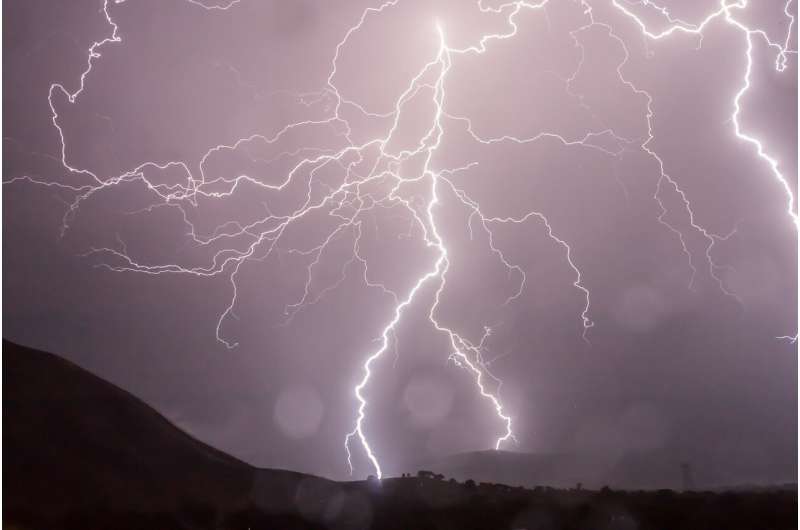Lightning strikes may trigger short-term thinning in the ozone layer

Crack! Lightning strikes are bright and loud—violent enough to shake your bones and light up the sky. Now, a new study led by the University of Colorado Boulder suggests that these powerful events may also alter the chemistry of Earth's atmosphere, even affecting Earth's all-important ozone layer.
The results, published in the Journal of Geophysical Research: Atmospheres, shed new light on what it means to live on a planet rife with lightning.
"You have about 1,800 active thunderstorms across the globe at any given time, generating about 50 flashes per second," said Robert Marshall, a coauthor of the new study and assistant professor in the Ann and H.J. Smead Department of Aerospace Engineering Sciences.
All that flashing may have a broader impact on the atmosphere than scientists once thought, he said.
The research hinges on a complicated phenomenon called lightning-induced electron precipitation, or LEP. Whenever lightning strikes, Marshall explained, the bolt shoots off a pulse of electromagnetic energy that can spread all the way around the Earth and into space. There, that energy interacts with the radiation belts that surround our planet, rattling loose some of the electrons trapped inside—which then rain back down toward Earth.
Picture it like shaking a tree branch to knock off wet snow.
In their new study, he and colleagues tracked the fallout from three thunderstorms over the last decade that stretched from Nebraska to the Caribbean. Based on their calculations, these individual storms may have kicked off a chemical chain reaction in the atmosphere that caused the ozone layer to shrink in certain locations by as much as 5%—a loss that potentially lasted for up to 12 hours.
Humans have lived with lightning for a long time, so those fluctuations in ozone likely don't threaten peoples' safety. But, Marshall said, the team's findings hint that—when spread over dozens of storms all happening at once—lightning could have a surprisingly big influence on what happens in the air above our heads. The researchers are hoping to study just how sizable that global influence is next.
"A single lightning strike has a minor impact on the atmosphere," Marshall said. "But over thousands of lightning strikes, it may be much more significant. We don't know yet."
Lightning crashes
It can also be something to behold. In October 2015, for example, Hurricane Patricia made landfall in Texas and Mexico. The storm brought some rain and flooding to the region—not to mention more than 33,000 lightning strikes over the span of just two-and-a-half hours.
In their latest research, Marshall and his colleagues used detailed computer simulations to follow what happened in the atmosphere after that wild event—plus a similar storm in the Caribbean in May 2017 and one more than roiled the skies above Nebraska in August 2013.
"These storms are triggering electrons to be removed from the radiation belts," Marshall said. "It dumps energy into the atmosphere, and we're asking what is that energy input doing to the atmosphere?"
Here's what happened: As the storms progressed, the electron energy raining down to Earth began to react with gasses high in Earth's atmosphere, roughly 30 to 70 miles above the surface. Concentrations of certain molecules in the air, including hydrogen oxides and nitrogen oxides, shot up almost at once. Nitrogen oxides, for example, increased by as much as 150%.
On their own, these gasses can't do much harm. But, Marshall said, they may mix deeper into the atmosphere, eventually reaching the ozone layer—an important boundary that sits less than 20 miles above the ground and helps to shield life from the sun's radiation.
"The increase in nitrogen oxides can last for 24 hour or more, and those gasses will slowly descend in altitude where they can destroy ozone," Marshall said.
The team doesn't expect that destruction to spread far away from the area just above the storm, creating a short-lived thin patch in the ozone layer. But the loss in ozone is comparable to what scientists have observed during other major atmospheric disturbances, including the aurorae, or Northern Lights, that make the sky glow at high latitudes.
Going forward, Marshall and his colleagues intend to keep an eye on those dark and stormy nights.
"In this study, we're looking at the effect of individual storms," he said. "The next step is to say what's the global, cumulative effect of lighting on the upper atmosphere."
More information: Wei Xu et al, Chemical Response of the Upper Atmosphere Due to Lightning‐Induced Electron Precipitation, Journal of Geophysical Research: Atmospheres (2021). DOI: 10.1029/2021JD034914
Journal information: Journal of Geophysical Research - Atmospheres
Provided by University of Colorado at Boulder



















